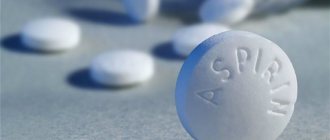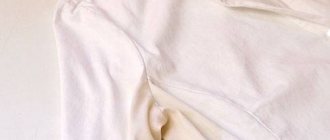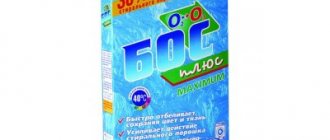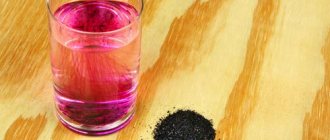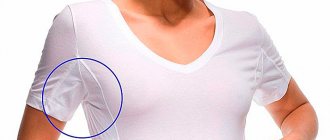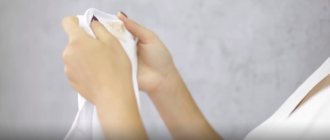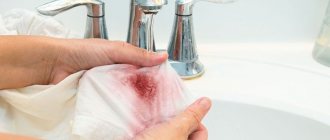Antiperspirants and deodorants are indispensable hygiene products that are used to treat the armpit area to prevent the appearance of sweat odor. They are popular with both sexes.
Sometimes, as a result of using these products, yellow marks appear on light-colored clothes, and white spots remain on dark-colored items. Let's look at ways to remove deodorant stains under the arms on black and colored clothes.
- Causes of deodorant stains
- Traditional methods for removing traces of antiperspirant
- Industrial stain removers
- Preventive measures
What to do if sweat stains are ingrained and cannot be washed off?
Despite the fact that the proposed options are effective, in some cases it is necessary to wash stains under the arms more than once. What to use to remove particularly stubborn stains: aggressive solvents:
- Apply table vinegar diluted by a third to the treatment area for 2 minutes, then wash off;
- Apply vodka without additives to all problem areas, rinse after 15-20 minutes;
- for 1 tbsp. l. citric acid or fresh lemon juice, take no more than 0.5 tbsp. warm water, pour the mixture onto the sweat stain, wait 15 minutes, wash.
The process of sweating helps a person get rid of salts, harmful substances and excess moisture.
https://www.youtube.com/watch?v=Ljt-b-x52k0
TV commercials tell how the deodorant reduces secretions and prevents clothes from getting wet. In practice, these products block unpleasant odor, but do not get rid of wet armpits.
The sweat that the armpit exudes penetrates deeply into clothing. It is difficult to wash off; it mixes with bacteria and fat present on the surface of the skin. A chemical compound is formed - 85% water and 15% fat and protein secretions. This cocktail makes the process of removing stains complex and time-consuming.
How to remove fresh stains
You should start washing clothes with sweat stains immediately after removing them. It is not at all necessary to resort to store-bought “chemicals” - simple and affordable products that can probably be found in any home can help. Let's look at how to remove sweat stains using traditional methods.
Method 1 - soapy
When it comes to fresh stains, there is no better cleaner than ordinary laundry soap - it is suitable for all types of fabric, from cotton to finicky wool, and can be used on both light and dark fabrics without the risk of leaving marks or etching paint.
The simplest method of using soap is to dilute the shavings in warm water and soak the affected item for about an hour and a half. This action applies to wool products, but with other types of fabrics it is recommended to proceed in a slightly different way:
- Rub the soap bar generously over the yellow marks;
- after half an hour, wash the treated areas by hand;
- wipe away traces of sweat with a sponge soaked in a solution of oxalic acid (1 teaspoon per glass of clean water);
- After another ten minutes, rinse thoroughly.
Method 2 - soda
How to remove yellow sweat stains with baking soda. This food product works as well as soap, and it can also be used on almost all types of fabric. To remove unpleasant stains, you need to mix the powder with a small amount of water to obtain a paste (about 4 tablespoons per 50 ml). Apply the resulting paste to the stains and leave for an hour to an hour and a half. This will be followed by a regular machine wash; it is better to dry the item at room temperature.
Method 3 - saline
Table salt also does an excellent job of removing sweat stains - just dissolve it in water at the rate of one handful per liter and immerse the stained item of clothing in the resulting solution. After an hour, the fabric remains to be carefully washed and rinsed.
Method 4 - peroxide
Hydrogen peroxide, which is sure to be found in every home medicine cabinet, is widely used in washing - for example, it perfectly rids clothes and towels of coffee stains. She can also remove yellow stains from sweat on white, and with a complete guarantee of safety for the fabric.
Old stains can be removed with clean, undiluted antiseptic, but recently appeared stains can be successfully removed with diluted solution: 1 table. spoon per liter of water. The liquid is applied locally in problem areas, after absorption, the item is washed in a machine. Traditional soaking is also not prohibited: in this case, hydrogen peroxide is poured into a bowl of warm water, the clothes are immersed for half an hour, and then dried without washing with powder.
Method 5 - vinegar
Vinegar is good because it not only removes stains, but also completely neutralizes the smell of sweat. It is most convenient to spray it on dirt from a spray bottle, in the form of an aqueous solution, although it can also be used for machine washing: measure a quarter cup of the product for every 10 liters of water.
Attention! Experimenting with vinegar is unacceptable when washing delicate fabrics, and especially silk items, but on the contrary, it is ideal for cotton and linen. Vodka diluted with water can be considered as a safe replacement.
If the stains are not in a hurry to come off the fabric, you can try this procedure:
- Dilute half a tablespoon of vinegar in 5 liters of water;
- soak soiled clothes for 30 minutes;
- After the expiration date, rub the stains with soda solution: 4 tbsp. spoons of powder per glass of heated water;
- leave the item to rest for another quarter of an hour, and then wash it in the usual way (it is best to use laundry soap). Industrial stain removers should be decisively abandoned - if the method does not work the first time, simply repeat all the steps again.
Get rid of after washing
If, after washing, your favorite wardrobe item does not get the desired appearance, and is full of stains from powder, detergent, or whiteness, we recommend resorting to the following, no less original methods.
Method No. 1
If a small, barely noticeable stain appears on your favorite T-shirt, but its very appearance causes negative emotions, inspect the item and evaluate the color. Select a felt-tip pen or marker to match the color of the damaged item and carefully, pointwise, paint over the area affected by bleach. After light “makeup”, iron the affected area through a piece of cloth so that the excess dye is absorbed into it.
This is interesting: The best way to remove hair dye stains from jeans, oil stains from white fabric
Method No. 2
This method is more suitable for youth T-shirts, which, even at the production stage, are painted with all sorts of colors, deliberately creating stains and streaks.
To carry out this kind of resuscitation efficiently, you will need fabric paint.
In any sewing store you can find all kinds of colors and shades.
Natural fabrics lend themselves best to resuscitation in this way.
Method No. 3
This method is only slightly different from the previous one: to perform it correctly, you will have to go to a fabric store or a nail store and buy acrylic paint in tubes (which is important).
The viscous consistency of this type of paint will allow you to independently draw an applique, a pattern that will cover up, and maybe even organically play up the stain from the cleaning agent.
After the acrylic paint has completely dried on the product, you need to take a piece of cloth, cover the painted area and iron it. Once heated, the acrylic paint will firmly adhere to dense fabric and the pattern you apply yourself will delight you for a long time!
This method is suitable for all types of tissue, but it is best to carry out such resuscitation on rough tissues.
Method No. 4
Suitable for creative people who know how to embroider with thread or ribbons. It’s very beautiful when a bleach stain on a blouse is skillfully hidden under neat embroidery, especially considering that in recent years embroidery has remained quite a fashionable and stylish wardrobe detail. Perhaps a speck of bleach or Domestos will encourage you to create an incredibly fashionable masterpiece?
Method No. 5
This is the easiest and fastest method and is suitable for almost all types of fabrics that can be heated. In order to save your item, you just need to buy a patch at any hardware store. Then, at home, you smooth out the damaged item, put the patch you like on it and iron it thoroughly. Fast and convenient!
Video
To learn how to save white clothes from yellow sweat stains, watch the following video:
Young mother, wife and part-time freelancer. Being a lawyer by training, I am accustomed to collecting and providing the most complete and reliable information. Constantly improves in the professional field and strives for personal growth and development.
Found a mistake? Select the text with the mouse and click:
The dishwasher cleans more than just plates and cups. You can load it with plastic toys, glass lamp shades and even dirty vegetables, such as potatoes, but only without using detergents.
The habit of using an automatic washing machine “sparingly” can lead to the appearance of an unpleasant odor in it. Washing at temperatures below 60℃ and short rinses allow fungi and bacteria from dirty clothes to remain on internal surfaces and actively multiply.
There are special traps to combat moths. The sticky layer with which they are covered contains female pheromones that attract males. By sticking to the trap, they are eliminated from the reproduction process, which leads to a decrease in the moth population.
Threads made of gold and silver, which were used to embroider clothes in the old days, are called gimp. To obtain them, the metal wire was pulled for a long time with pliers to the required fineness. This is where the expression “to drag out the rigmarole” came from - “to do long, monotonous work” or “to delay the completion of a task.”
Before removing various stains from clothing, you need to find out how safe the selected solvent is for the fabric itself. It is applied in a small amount to an inconspicuous area of the item from the inside out for 5-10 minutes. If the material retains its structure and color, you can move on to stains.
Fresh lemon is not only suitable for tea: clean dirt from the surface of an acrylic bath by rubbing with half a cut citrus, or quickly wash the microwave by placing a container of water and lemon slices in it for 8-10 minutes at maximum power. The softened dirt can simply be wiped off with a sponge.
Stretch ceilings made of PVC film can withstand from 70 to 120 liters of water per 1 m2 of their area (depending on the size of the ceiling, the degree of its tension and the quality of the film). So you don’t have to worry about leaks from neighbors above.
If your favorite things show the first signs of gestation in the form of untidy pellets, you can get rid of them using a special machine - a shaver. It quickly and effectively shaves off clumps of fabric fibers and returns things to their proper appearance.
The easiest way to remove scale and carbon deposits from the soleplate of the iron is with table salt. Pour a thick layer of salt onto the paper, heat the iron to maximum and run the iron over the salt bed several times, applying light pressure.
Colored and dark things
On dark and colored things, sweat stains are not as noticeable as on white ones. But still, such traces are visible and look like dark stains with a whitish outline from the salt contained in a person’s sweat. It is worth noting that for black and colored fabrics you should not use bleaching agents, including: peroxide, citric acid, and soda. In addition to them, there are other, no less accessible means that can cope with such contaminants.
Laundry soap
An excellent method, however, it works mainly with fresh stains. The procedure is simple:
- Thoroughly rub soap on the contaminated area of clothing.
- Leave the item for an hour.
- After the allotted time has passed, rinse the item and throw it in the washing machine.
Salt and ammonia
Suitable mainly for linen and cotton clothes. To remove stains from black clothes you will need:
- Dilute salt (1 tablespoon) and ammonia (1 teaspoon) in a glass of water.
- Pour the resulting solution onto the stained area and leave for an hour.
- Wash the item by hand or in a machine.
Salt and soap
- Prepare a soap solution in a basin in which to soak the item to be washed for half an hour.
- Dissolve two tablespoons of salt in a glass of water.
- Apply the resulting solution to the stains and leave the clothes there for a couple of hours.
- Wash and rinse the item as usual.
Vinegar
- Table vinegar (two tablespoons) should be dissolved in six liters of water.
- Immerse the clothes to be washed in the resulting solution and let stand for about half an hour.
- Dilute ammonia with water in a ratio of 1:2
- Treat contaminated areas with a cotton pad or white cloth soaked in the resulting solution.
- Wash and rinse clothes.
White spirit and ammonia
Dilute white spirit and ammonia in a ratio of 2:1, then pour this solution over the stains without rubbing and leave in this position for a couple of hours. After the allotted period of time, rinse thoroughly and put the item in the washing machine.
Preparatory process
Not many people know how to remove white spots on black clothes in order to preserve the color and not spoil the item. To effectively clean the product, the first step is to determine the origin of the contamination; white remains on black from:
- deodorants;
- decorative cosmetics;
- sweat;
- glue.
Light stains remain from detergents that were poorly rinsed during washing; they are easy to deal with; just do an additional rinse in the machine. The glue is removed using special chemicals in dry cleaning; other stains can be removed at home. You don’t have to make any special efforts; everything you need for cleansing is in every home’s kitchen and medicine cabinet.
Before removing white stains from black clothes, their origin is determined. Select a removal method, test the product on an inconspicuous area of the product, if the tissue reacts normally, carry out the cleaning process. Washing the entire wardrobe item after the manipulations is required.
Causes of stains on clothes under the arms
Sweating is an integral part of the normal functioning of our body, and is not always comfortable in everyday life. Stress, excess body weight, changes in hormonal levels, increased thyroid function, banal heat outside - all this can cause increased moisture secretion in the armpits.
In fact, the sweat of a healthy person is colorless and does not have a pronounced odor. Stains on fabric are mostly caused by dried stains. Yellow stains on white clothes and white stains on dark ones are the result of mixing antiperspirant/deodorant with secretions from the sweat glands. There is another reason, but not so harmless - chromohidrosis, a malfunction of the sweat glands, as a result of which the sweat acquires an unusual color, and therefore noticeably stains clothes.
How to remove traces of deodorant on different fabrics?
First of all, you should try washing things in the washing machine using different programs. Only if this does not bring the expected result, you need to move on to all sorts of “improvised” methods. It is worth considering that they do not always give a guaranteed result, since the conditions for the formation of stains change all the time. Therefore, the methods given are rather advisory in nature.
Stains on colored fabric
Due to the fact that such fabrics contain dyes, they react extremely sharply to products with active and aggressive components. Therefore, they should be used last. Typically used to clean colored fabrics:
Table salt
Before you wash deodorant from clothing under your arms, the stain must be thoroughly moistened with a saline solution.
The washing effect will be enhanced if you first apply a saline solution to the stain.
Dishwashing liquid
The affected area is treated directly with a gel or solution and left for half an hour. Then - normal washing.
Regular dishwashing detergent will help remove the stain.
Egg yolk and denatured alcohol
Both components are mixed in equal parts, and the resulting mixture is applied to the stain. Let it sit for about half an hour, then rinse with water and wash.
Egg yolk is mixed with alcohol and applied to the fabric.
Stains on white fabric
White tissue is more “calm” towards various active substances, so they can be used relatively fearlessly. These include vinegar, citric acid, hydrogen peroxide, as well as alcohol and alcohol-containing liquids. In addition, regular laundry soap can be quite effective.
Stains on white fabric can be removed using active substances.How to remove underarm deodorant stains on black fabric?
The same strong brine or soap is still considered a good remedy. In some cases, aspirin shows sufficient effectiveness. To do this, a couple of tablets need to be crushed to a powder-like state and dissolved in a glass of water. Dampen the stain and rub with a brush or rough cloth. Wash as usual.
Stains can be removed from black fabric in slightly different ways.
You can also use ammonia: soak the laundry in a solution of ammonia (20 ml per liter of water) and wash by hand.
You can soak the item in a solution of ammonia.
Traces of deodorant on cotton fabric
It is best to treat such clothes with saline solution or laundry soap. Alcohol or vinegar can only be used if the fabric is thick.
Cotton fabric is processed more carefully.
How to remove traces of deodorant on wool and linen fabric?
Salt, soap or soda will come in handy here. A weak alcohol solution can give a good effect: 1 ml. per glass of water. In severe cases, sodium thiosulfate sometimes helps: soak the laundry in water and add 10 grams. drug. Leave for 20 minutes, then rinse and wash.
Stains are removed from linen clothes using alcohol.
Deodorant on thin knitwear
Delicate fabrics should not be cleaned with any aggressive substance. Therefore, it is better to use special, industrial products here, and you need to wash them by hand!
Thin knitwear should be washed by hand.
As a rule, ammonia is used for this.
Traces of sweat on artificial silk fabric
You can remove stains with a weak saline solution, vinegar, or glycerin. In the latter case, you need to heat a small amount of it in a water bath and treat the stain. After 15 minutes, the fabric should be rinsed in warm water and washed.
Artificial silk requires very careful handling.
How to remove sweat from clothes
First you need to understand the nature of this very unpleasant phenomenon. These stains are formed as a result of the work of the human body, which by sweating gets rid of not only moisture, but also excess fats and salts, which penetrate tightly into the fibers of clothing and remain there after drying.
Information. Deodorants also make their contribution, the particles of which are designed to remove unpleasant odors. However, their excess, along with fats and salts, “moves” to live on the fabric.
Wash dark ones on shirts
Despite the fact that it is very difficult to remove armpit stains from clothes, and especially from shirts, there are a lot of effective options and folk methods for this enterprise.
How to remove dark sweat stains from armpits
If the stains are so fresh that they are even wet, then it is reasonable to rub the armpit area of the T-shirt with laundry soap.
Then put a slurry of wet soda on the soap, leave it for an hour and a half, then wash it in the usual way.
A way to remove wet sweat stains from shirts
- For this method we will need a kettle, a tablespoon of soda and a tablespoon of salt;
- Heat 250 ml of water;
- Add salt and soda to it, stir;
- Pour the resulting elixir of purity onto the stains, leave for 2-3 hours, and wash in the usual way.
A way to remove yellow stains under the arms on clothes. Essentially, a slightly modified second method, where liquid soap is used instead of water, naturally in smaller quantities.
Remove white on black
Method No. 1 A very simple but effective method:
- Take dish liquid;
- Dilute it with water and washing powder;
- Leave the affected items soaked overnight;
- In the morning, rinse the items to remove excess soap and wash them as usual.
Method No. 2
This method of removing stains from the armpit area is widely known throughout the post-Soviet space.
For this you will need aspirin (acetyl salicylic acid), water and the affected item itself.
An aspirin tablet must be moistened with water, brought to a mushy state and rubbed on the stained area.
After thirty minutes, wash the item in the most ordinary and familiar way.
Method No. 3
If there is no aspirin in the house, you can use a wonderful method based on peroxide, which is more likely to be found in every home. Just take a bottle of peroxide and pour it onto the contaminated area. After twenty to thirty minutes we wash the item.
Method No. 4
Suitable only for dark and colored items! This method can be dangerous for white items as it may leave behind yellow stains. In the evening, we moisten the stain with vinegar, and in the morning we wash the item in the mode in which you always wash clothes.
Method No. 5
This method will help you remove white deodorant stains from black clothes. You will need some vodka, which should be poured in a small amount onto the stained area. After half an hour or an hour, wash the item as usual. If the stain does not want to give up, repeat the procedure after the item has dried.
Very often, such stains are formed not only due to the chemical elements released by our body, but also due to the chemical composition of our favorite deodorants.
Important! If you want to minimize the likelihood of similar stains appearing again in the future, avoid deodorants that contain aluminum.
It’s easier to remove fresh stains than those that are “a hundred years old.”
Old stains are more difficult to deal with, and if you use strong products, you risk ruining the item.
Therefore, every time you come home you need to pay attention to the external condition of the thing, its dirtiness. Attention! There are ways to remove such stains using acetone, but under no circumstances should acetone be used on colored fabrics! All acetone-containing methods are only suitable for white fabrics.
Attention! There are ways to remove such stains using acetone, but under no circumstances should acetone be used on colored fabrics! All acetone-containing methods are only suitable for white fabrics.
Best chemicals: table
| Name/price | Peculiarities | Flaws |
| Vanish Gold/300 rub. |
|
|
| Ecover/400 rub. |
|
|
| Amway spray stain remover (Amway)/700 rub. |
|
|
| Dr. Beckmann Spray stain remover “Deodorant and sweat” (Doctor Beckman)/300 rub. |
|
|
| Unique from HG spray for sweat stains (Unique from AshG)/450 RUR. |
|
|
Tip: The easiest way to remove fresh yellow stains under the arms on white material is with an oxygen stain remover.
Traditional methods
There are a large number of different stain removers on the modern market. Not all of them are equally effective. As part of any stain remover, well-known folk methods are used as a base. To remove stains from colored and black, you can use one of them directly.
Salt
To remove deodorant stains from clothes, the stained areas must be moistened with warm water. Then apply table salt generously. The treated item should be left in this form for 5-10 hours. In this case, it is necessary to avoid drying out and periodically moisten the treated areas.
After the required amount of time has passed for the stains to disappear, the clothes should be rinsed and then washed in the usual way.
Vinegar
Table vinegar 9% is widely used in everyday life to combat stains of various origins. In this case it is also effective. In its pure form, it is generously applied to places of contamination using a cotton pad. Then the item should be left for 1.5-2 hours. Then wash in the washing machine.
Lemon juice
Freshly squeezed lemon juice should be applied to contaminated areas. It should saturate the fabric completely. Therefore, you will need to take at least 1 tbsp. l. The treated product is left for 40-60 minutes. Then it should be rinsed thoroughly and washed.
Are you unplugging your washing machine?
Oh yes! No
Liquid dishwashing detergent
Successfully copes with most difficult stains. In this case, a gel containing glycerin is suitable. Apply the substance generously to antiperspirant stains and leave for 30 minutes. Then the item should be soaked completely and left for another 1 hour. After that, wash it.
Alcohol or vodka
You can get rid of white spots using one of these products. In its pure form, vodka is applied to contaminated areas for 30-40 minutes. Then the item should be washed using washing powder.
Important! Vodka is applied to dirt in its pure form. The alcohol should be pre-diluted with water 1:1
Ammonia
Mix in equal proportions with water. This liquid must be applied liberally to the fabric in contaminated areas. After waiting 30-40 minutes, the item should be washed in the usual way.
Hydrogen peroxide with baking soda and dish soap
The mixture of these products successfully copes with most complex stains that are difficult to remove. Take baking soda and dishwashing detergent in equal proportions and mix. To the resulting paste you should add peroxide 1:4 (4 parts mixture of soda and gel, 1 part peroxide).
The composition must be applied to the stains and left to act for 2 hours. Then the item should be washed.
Nylon stocking or sock
To get rid of white traces of antiperspirant on black clothes, rub the stained area with a nylon stocking until the desired result is achieved. Then wash the product as usual.
A mixture of borax, kefir and table vinegar
You can get rid of traces of deodorant using this composition. All components are taken in equal parts. The resulting homogeneous mass should be applied to the item using rubbing movements and left to act for 40-50 minutes.
Aspirin
Tablets in the required quantity should be crushed into powder and sprinkled onto stained areas pre-moistened with warm water. Leave to act for 1 hour.
Denatured alcohol or white spirit
Denatured alcohol successfully removes deodorant stains under the arms on colored and black clothes. They should soak contaminated areas and leave for 60 minutes to act. Then the item must be washed using washing powder.
Hyposulfite
Dilute with water 1:1 and soak the item in the resulting solution for 30-60 minutes, depending on the area and persistence of the stains. After this, the product should be rinsed thoroughly.
How to remove with household chemicals?
You can get rid of stains on fabric using household chemicals. Available compositions:
- laundry soap - for the best effect, grate it, dilute it with water, and then apply it to the stain in the form of a paste;
- dishwashing liquid - it can be used to treat almost any stain; it is especially effective if the stains are fresh;
- Washing powder is the No. 1 remedy in the fight against various stains.
In addition to classic household chemicals, stain removers are used to remove stains from fabrics. Top 3 best lineups:
Bagi
Universal stain remover for 100 types of stains. The product is available in the form of a spray. The average cost is 350 rubles per package. Read reviews here, here and here.
BioMio
Universal stain remover . The liquid is used to treat stubborn stains; it is suitable for children's clothes and products of different colors. Price – 170 rubles. Read reviews here, here and here.
Vanish Gold Oxi Action
Universal stain remover. The product does not contain chlorine or other aggressive components and is suitable for combating complex stains. Price - from 320 rubles. Read reviews here, here and here.
Ways to remove traces of sweat from things
In any case, it is important to know how to get rid of yellow spots when they appear. There are many ways to help with this
1Use of laundry soap. It is an excellent assistant in the fight against sweat stains on white. To do this, you need to wet the item and rub the contaminated areas with soap. Leave the clothes in this form for 10-15 minutes, and then rub the soapy areas with your hands. Despite the untidy appearance of laundry soap and its unpleasant smell, after washing there will be no trace of stains.
2How to get rid of yellow stains when using baking soda? First you need to prepare a soda paste. Mix a small amount of baking soda with water until a paste forms. Now apply the prepared product to the wet item and rub it a little with a brush. After this, we wash the item as usual. This method is excellent for removing stains from white clothes.
3Hydrogen peroxide. This method will remove yellow sweat stains that are outdated. You need to prepare a special paste. To do this, take 2 spoons of soda, 1 spoon of gel and 30 ml of hydrogen peroxide. Mix everything thoroughly and apply to the old spot, leave for 10 minutes, then clean with a brush. If it was not possible to remove the yellowness from things in one go, then you can repeat the cleansing procedure again.
It is important to remember: after washing, it is advisable to dry the item in the shade, because if the fabric is not natural, then yellow stains will remain on it.
4Aspirin is suitable for removing yellow stains from both black and white clothes. How to remove yellow marks with aspirin? You need to grind the tablet into powder and add a little water to make a thick mixture
Now it can be applied to the problem area, after moistening it with warm water. To achieve a good result, you need to leave the mixture on the clothes for several hours, then wash the item with powder and rinse well.
5Baking soda and salt will help get rid of yellow spots. It is better to use fine salt. The same amount of soda and salt should be mixed with liquid soap, and then applied to the yellow areas under the arms. This method will definitely help get rid of the unwanted problem.
6Remove yellowness using ammonia. Mix ammonia with a small amount of salt and apply to the surface of the fabric. We give it time to act so that the dirt dissolves, and then we wash the item in the usual way.
7Vinegar or citric acid. Dilute 1 tsp. vinegar or citric acid with a glass of water and rub the armpits well with this solution. In order for the product to have time to dissolve the remaining sweat on the fabric, you need to give it 2-3 hours. This method is suitable for colored and white clothes, so you can safely use it. It is important to remember that if vinegar is used, then the washed item must be rinsed well several times in order to remove the pungent odor.
8How to remove yellowness with vodka? You need to rub the resulting stain with vodka, and then wash it in the usual way. Do not be alarmed if the yellowness becomes more intense at first - after washing it will be completely removed. This method is suitable for small, fresh stains, since vodka is not able to remove old stains.
9 Oxygen bleaches without chlorine. Specially formulated stain removers can effectively get rid of yellow spots under the arms. It is recommended to carefully study the instructions before use so as not to damage the fabric.
10How to remove stains using boiling. It is worth knowing that it is only suitable for cotton fabrics. This method is great for removing old stains that cannot be removed using other methods. For boiling you will need: finely grated laundry soap, water and an aluminum boiling container. Pour the soap into water and bring to a boil, put the item with the stain in it and boil for several hours, depending on the degree of contamination.
We recommend that you read
After boiling, it is recommended to rinse the items thoroughly with the addition of fabric softener. It will help restore the fabric after prolonged digestion and give it freshness.
Down with fat and wax!
Fat is found in many dishes, as well as cosmetics and household products, and regular washing does not always help remove it. Therefore, fresh greasy stains should be treated with adsorbents. Most often it is recommended to sprinkle them thickly with starch, talcum powder or cosmetic clay, cover the top with paper or loose cloth and leave under pressure for several hours . To speed up the process, you can iron the powder on top with a hot iron, changing it several times.
In a similar way, you can remove drips from wax or stearin candles. First you need to scrape off the frozen mass, then put loose paper on top and bottom and iron it several times with a heated iron. You can remove old grease stains using turpentine or gasoline, wiping them from the edge to the middle. When the trace of dirt becomes barely noticeable, the product must be finally washed and dried in fresh air.
How to remove stubborn stains of sweat
Removing stubborn yellow stains can be challenging, but using the right home remedies can help save your favorite items.
Baking soda can remove traces of sweat, antiperspirant or deodorant. The product is safe for white items made from various materials. At the same time, it not only removes dirt, but also eliminates the smell of sweat and disinfects.
To prepare a soda solution, dissolve 4 tbsp in 125 ml of water. l. soda Treat the stained area with the resulting product and leave for 2 hours. After soaking, wash the product with powder and rinse well in cool running water.
Salt will help save white clothes made of silk, linen or cotton. Dilute sodium chloride with a little water to make a paste. Apply the product to the stain and leave overnight. Wash your clothes following the recommendations for the type of fabric.
Aspirin will help remove old sweat stains on white clothes:
- Grind 4 tablets of acetylsalicylic acid to a powder.
- Add some water to the aspirin. The result of combining the two components should be a paste.
- Apply the product to the stain and rub in a little, avoiding strong mechanical impact.
- Leave the item for 3 hours and then wash or rinse the item in cool water.
An aspirin solution will help remove traces of sweat from delicate fabrics. Dissolve two acid tablets in 125 ml of water. Treat the stain with the resulting product and leave for half an hour.
To remove sweat stains, you can use bleach - “Persol”. When working with it, follow safety precautions: wear gloves and avoid getting the product on the mucous membranes of the mouth and eyes.
How to remove yellow stains on armpits on white using bleach:
- Dissolve a teaspoon of the product in a glass of water.
- Using an old toothbrush, rub the bleach into the stain, avoiding applying too much pressure.
- Leave the treated clothing for an hour and a half, then wash and dry.
Persol is not suitable for clothing made from delicate materials.
Boiling will help remove yellowness from cotton products. Prepare a large container, fill it with water and add grated laundry soap. Additionally, you can use chlorine-free bleach. Place the clothes in a saucepan and place it on the heat for 3 hours. At the end of the procedure, rinse the products in clean cool water using conditioner.
Preventive measures and videos
Stubborn stains from antiperspirants and deodorants cause a lot of trouble. They are difficult to remove and much easier to prevent if you follow preventive recommendations. Proper use of deodorants makes it possible to avoid problems. More details:
- It is necessary to give preference to quality products. Despite the fact that their cost can be several times higher, they are much more economical to use.
- Don't overuse antiperspirant. A thin, moderate layer is enough to protect yourself from odor and traces of sweat all day long.
When using sprays, they should be sprayed from a distance of at least 20 cm. Before using deodorant, the skin must be completely dry and clean
It is important. Gels and sticks dry in about 10 minutes, and aerosols in about 5. You can put on clothes only after the deodorant has completely dried.. https://www.youtube.com/embed/tuTjZYBbKK4
https://youtube.com/watch?v=tuTjZYBbKK4
White stains from deodorants and antiperspirants on colored and black clothes are classified as complex stains. The molecules of the products penetrate deeply into the fibers of fabrics and have water-repellent properties. This is why it is so difficult to get rid of them. You can remove traces of deodorant using any of the described products.
How to avoid new ones
- To prevent antiperspirant stains from forming under the arms, simply do not wear anything until the product has dried. It is worth waiting a few minutes after application.
- Use industrial stain removers with a preventive function.
- Regularly observe personal hygiene rules.
When your armpits are wet throughout the year, you need to see a doctor. Factors influencing high sweating: excessive coffee consumption, smoking, passion for fatty and salty foods, regular stress.
Marks under the arms look unattractive and bring a significant amount of discomfort into our lives. But you shouldn’t throw away a thing as soon as a trace appears on it that is difficult to remove in the usual way. Try the methods we have suggested to combat this problem and happily wear your favorite clothes.
Useful tips
Before looking for the means in your arsenal to combat sweat stains, let's figure out what exactly you shouldn't wash off such problematic stains so as not to completely ruin the thing. Well, some useful recommendations from experts will not be superfluous:
- Never use chlorine bleach on either colored or white fabrics. The fact is that the chlorine in its composition reacts with proteins present in sweat. This may cause the fabric fibers to darken and the stain to become even more noticeable.
- Do not wash such items in hot water. It can only contribute to the consolidation of contaminants. Traces of sweat are best washed at a temperature no higher than 30 degrees.
- It is also recommended to dry washed items in the shade, rather than in the open sun or on a radiator.
- Silk products do not tolerate treatment with acetic acid and acetone, synthetics do not like gasoline and all its derivatives, cotton fabrics should not be treated with acids, and wool should not be treated with alkaline solutions.
- Acetone can discolor fabric, so do not use it to remove traces of sweat on colored clothing.
- After using hydrogen peroxide, rinse the treated clothing several times.
- Before using any product, be sure to test it on a small, inconspicuous area of clothing, preferably on the reverse side. If the fabric is discolored or deformed, it is better to choose another product.
- It is always easier to remove fresh marks than old ones, so treat stains as soon as they appear, so you have a better chance of getting rid of them 100%.
- Sweat stains appear not only from sweating, but also from the use of deodorants themselves. It is advisable to wash problem areas with laundry soap every time after using an antiperspirant. In this case, the likelihood of stains appearing will be much less.
Shading
If the stain left on clothing by white occupies a very small area, then you should try to hide it using a marker or pencil of the same color as the item itself.
- You need to choose a pencil or marker of the same color as the damaged item.
- Next, you need to completely paint over the stain.
- Turn the damaged item of clothing inside out.
- Iron the painted area with an iron.
But if whiteness has damaged black fabric, then cosmetic mascara would be an excellent option. But drawing ink will cope with the task most efficiently. This artistic material is so absorbed into the fabric that it will never wash off the item of clothing, so there will be no need to adjust the area painted with it.
How to get rid of stains on a tablecloth


